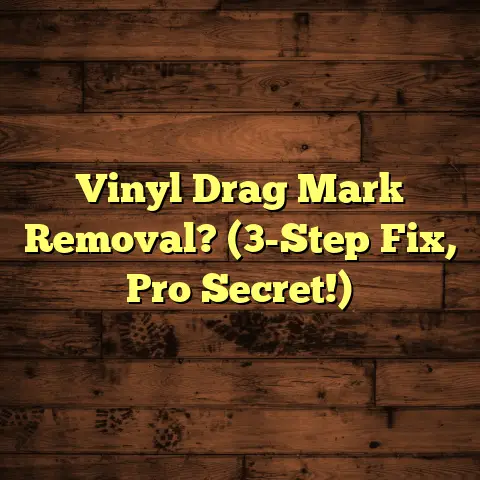Epoxy Floor Durability: Guide? (4 Flaws Exposed!)
I’m talking luxury homes, swanky restaurants, and even high-tech industrial spaces. Epoxy floors have that “wow” factor that can really transform an environment.
That seamless appearance, the way light bounces off the surface, and the sheer variety of colors and designs… it’s no wonder epoxy is so popular.
But before you jump on the epoxy bandwagon, let’s get real. As a flooring contractor with years of experience, I’ve seen it all. And while epoxy has its perks, it’s not always the perfect solution.
So, let’s dive into the world of epoxy floors, exploring the good, the bad, and the downright ugly. Trust me, you’ll want to know this before you make a decision.
Understanding Epoxy Flooring
Okay, so what exactly is epoxy flooring? Simply put, it’s a flooring system made up of multiple layers of epoxy resin.
This resin is a mix of polymers and hardeners that, when combined, create a super durable and chemical-resistant surface. Think of it as a super-strong, liquid plastic that hardens into a solid coating.
Installation involves a meticulous process. First, the existing floor needs to be properly prepped. This means cleaning, grinding, and repairing any cracks or imperfections.
Then, the epoxy is mixed and applied in thin layers. Depending on the type of epoxy and the desired look, multiple coats might be needed. And finally, it needs to cure properly, which can take anywhere from a few days to a week.
Now, there are different types of epoxy flooring, each with its own characteristics:
-
Solid Epoxy: This is the strongest and most durable type, ideal for high-traffic areas and industrial settings.
-
Water-Based Epoxy: Lower in VOCs (volatile organic compounds), making it a more eco-friendly option. However, it’s not as durable as solid epoxy.
-
Solvent-Based Epoxy: Offers excellent adhesion and chemical resistance, but it contains strong solvents that can be harmful to the environment and require proper ventilation during installation.
Why the rise in popularity, especially in luxury settings? Well, besides the aesthetics, epoxy floors offer a ton of functional benefits:
- Seamless: No grout lines means easy cleaning and a sleek, modern look.
- Durable: Resistant to stains, chemicals, and impacts (to a certain extent, as we’ll see later).
- Customizable: Endless color and design options, including metallic finishes and decorative flakes.
- Hygienic: Non-porous surface prevents the growth of bacteria and mold.
The Allure of Durability in
Luxury Flooring
When you’re investing in a luxury space, durability is key. You want materials that not only look amazing but also stand the test of time.
Think about it: high-end hotels, exclusive boutiques, and luxury homes all need flooring that can withstand heavy foot traffic, spills, and the occasional mishap.
That’s where epoxy flooring comes in. Its inherent properties make it a seemingly ideal choice for these environments.
For starters, epoxy is incredibly resistant to stains. Red wine, coffee, oil… you name it, epoxy can usually handle it without leaving a permanent mark.
It’s also resistant to a wide range of chemicals, making it perfect for garages, workshops, and even labs. And it can withstand heavy impacts, which is essential in areas where things might get dropped or dragged around.
This durability aligns perfectly with the expectations of luxury homeowners and business owners. They’re looking for long-lasting investments that won’t require constant repairs or replacements.
They want floors that can handle the demands of daily life while still looking pristine. And on paper, epoxy seems to deliver on that promise.
But here’s the thing: while epoxy is undeniably durable, it’s not invincible. And there are some significant flaws that can affect its performance, especially in luxury settings where perfection is the name of the game.
Flaw #1 – Prone to Scratches
and Dents
Okay, let’s get to the first major flaw: epoxy floors are prone to scratches and dents, despite their reputation for durability.
I know, it sounds contradictory, right? But trust me, I’ve seen it happen time and time again.
Imagine this: you’ve just installed a beautiful epoxy floor in your luxury kitchen. It looks stunning! But then, a few weeks later, you notice a faint scratch near the island.
Or maybe you’re running a high-end boutique with epoxy floors, and you start seeing small dents and scuffs in high-traffic areas.
What gives? Well, while epoxy is resistant to impacts, it’s not completely immune to them. Heavy furniture, sharp objects, and even everyday foot traffic can leave their mark.
Think about it: stilettos, pet claws, and dropped keys can all scratch the surface of an epoxy floor. And while the scratches might not be immediately noticeable, they can accumulate over time and dull the overall appearance.
Dents are another issue. If you drop something heavy on an epoxy floor, it can leave a permanent indentation. This is especially common in garages and workshops, but it can also happen in homes and businesses.
The type of epoxy used also plays a role. Softer epoxy formulations are more prone to scratches and dents than harder ones. And if the epoxy wasn’t applied correctly or didn’t cure properly, it can be even more vulnerable.
So, what can you do to prevent scratches and dents? Here are a few tips:
- Use furniture pads: Place furniture pads under all heavy furniture to prevent scratches and dents.
- Avoid dragging objects: Always lift and carry heavy objects instead of dragging them across the floor.
- Use mats in high-traffic areas: Place mats at entrances and in high-traffic areas to protect the floor from scratches and dirt.
- Choose the right epoxy: Work with a professional to choose the right type of epoxy for your needs and ensure proper installation.
Flaw #2 – UV Sensitivity and
Color Fading
Let’s talk about another sneaky flaw of epoxy flooring: UV sensitivity and color fading. This is something that many people don’t consider, but it can have a significant impact on the visual integrity of your space.
Here’s the deal: some epoxy formulations are sensitive to ultraviolet (UV) light. When exposed to sunlight, they can start to yellow or fade over time.
This is especially noticeable in lighter colors and clear epoxy coatings. Imagine installing a beautiful white epoxy floor, only to see it turn a dingy yellow after a few years. Not exactly the luxury look you were going for, right?
This flaw is particularly problematic in spaces with large windows or outdoor access. Sunlight streaming through the windows can accelerate the fading process, especially in areas that receive direct sunlight.
I’ve seen this happen in restaurants with large windows, showrooms with glass doors, and even homes with sunrooms. The areas exposed to sunlight start to look noticeably different from the areas that are shaded.
So, what can you do to mitigate the effects of UV light? Here are a few strategies:
-
Choose UV-resistant epoxy: Opt for epoxy formulations that are specifically designed to resist UV damage. These epoxies contain UV inhibitors that help protect the color from fading.
-
Use window treatments: Install window treatments like blinds, shades, or curtains to block out direct sunlight. This can help reduce the amount of UV light that reaches the floor.
-
Apply a UV-resistant topcoat: Consider applying a UV-resistant topcoat to your epoxy floor. This will provide an extra layer of protection against UV damage.
-
Regular cleaning: Regularly clean your epoxy floor to remove dirt and grime that can accelerate fading.
Flaw #3 – Installation Challenges
and Time Constraints
Now, let’s talk about the installation process. While epoxy flooring can look amazing, it’s not always easy to install, especially in high-end properties where aesthetics and precision are paramount.
The installation process is time- consuming and requires a high level of skill and attention to detail. It’s not something you can just DIY on a weekend.
First, the existing floor needs to be thoroughly prepped. This means cleaning, grinding, and repairing any cracks or imperfections. If the surface isn’t perfectly smooth and clean, the epoxy won’t adhere properly, and you’ll end up with a bumpy, uneven floor.
Then, the epoxy needs to be mixed correctly. The ratio of resin to hardener is crucial, and any mistakes can affect the curing process and the final result.
And finally, the epoxy needs to be applied in thin, even layers. This requires a steady hand and a lot of patience. If the epoxy is applied too thickly, it can bubble or crack.
But here’s the real challenge: timing. Epoxy has a limited working time, which means you need to work quickly and efficiently. And once the epoxy is applied, it needs to cure properly, which can take several days or even a week.
During the curing process, the floor can’t be walked on or exposed to moisture. This can be a major inconvenience, especially in businesses that need to stay open.
I remember one project where we were installing epoxy floors in a high-end restaurant. The restaurant had to close for a week while the floors cured, which cost them a lot of money. And to make matters worse, the weather was unusually humid, which slowed down the curing process and delayed the reopening.
So, what can you do to minimize installation challenges and time constraints? Here are a few tips:
-
Hire a professional: Don’t try to install epoxy floors yourself, especially if you’re not experienced. Hire a professional contractor who has the skills and equipment to do the job right.
-
Plan ahead: Work with your contractor to develop a detailed installation plan that takes into account the curing time and any potential disruptions.
-
Control the environment: Maintain a consistent temperature and humidity level during the installation and curing process. This will help ensure that the epoxy cures properly.
-
Be patient: Don’t rush the installation process. Allow enough time for the epoxy to cure completely before walking on the floor or moving furniture back in.
Flaw #4 – Maintenance and Repair
Difficulties
Finally, let’s talk about maintenance and repair. While epoxy floors are relatively easy to clean, they do require some specialized care to preserve their appearance and durability.
For starters, you can’t just use any cleaning product on an epoxy floor. Harsh chemicals and abrasive cleaners can damage the surface and dull the finish.
Instead, you need to use gentle, pH-neutral cleaners that are specifically designed for epoxy floors. And you should avoid using abrasive scrubbers or scouring pads, as they can scratch the surface.
But the real challenge comes when you need to repair damage. Chips, cracks, and stains can be difficult to fix, especially in luxury settings where aesthetics are paramount.
Small chips and cracks can sometimes be repaired with epoxy patching compounds. But if the damage is extensive, you might need to re-coat the entire floor.
And stains can be particularly tricky. Some stains can be removed with specialized cleaning products, but others might be permanent.
I remember one project where a client spilled red wine on their epoxy floor. They tried to clean it up right away, but the stain wouldn’t come out. We ended up having to re-coat the entire floor to get rid of the stain.
So, what can you do to make maintenance and repair easier? Here are a few tips:
-
Use the right cleaning products: Only use pH-neutral cleaners that are specifically designed for epoxy floors.
-
Clean up spills immediately: Wipe up spills as soon as they happen to prevent staining.
-
Protect the floor from damage: Use mats and rugs in high-traffic areas to protect the floor from scratches and dents.
-
Hire a professional for repairs: Don’t try to repair damage yourself, especially if you’re not experienced. Hire a professional contractor who has the skills and equipment to do the job right.
Conclusion: Weighing the Luxury
Against the Flaws
So, there you have it: the allure of epoxy flooring as a luxurious choice, along with the four significant flaws that can affect its durability and desirability.
Epoxy floors can be a stunning addition to any space, offering a seamless, durable, and customizable surface. But they’re not without their drawbacks.
Scratches, UV sensitivity, installation challenges, and maintenance difficulties can all impact the long-term performance and appearance of epoxy floors.
When choosing flooring for high-end projects, it’s crucial to weigh these factors carefully. Consider the specific needs of your space, the level of traffic it will receive, and the amount of maintenance you’re willing to undertake.
Talk to a professional flooring contractor who can help you assess your options and choose the right flooring solution for your needs. And don’t be afraid to ask questions and do your research.
Ultimately, the decision is yours. But by being informed and aware of the potential flaws, you can make a choice that will bring you years of beauty and satisfaction.
Hope this helps!





